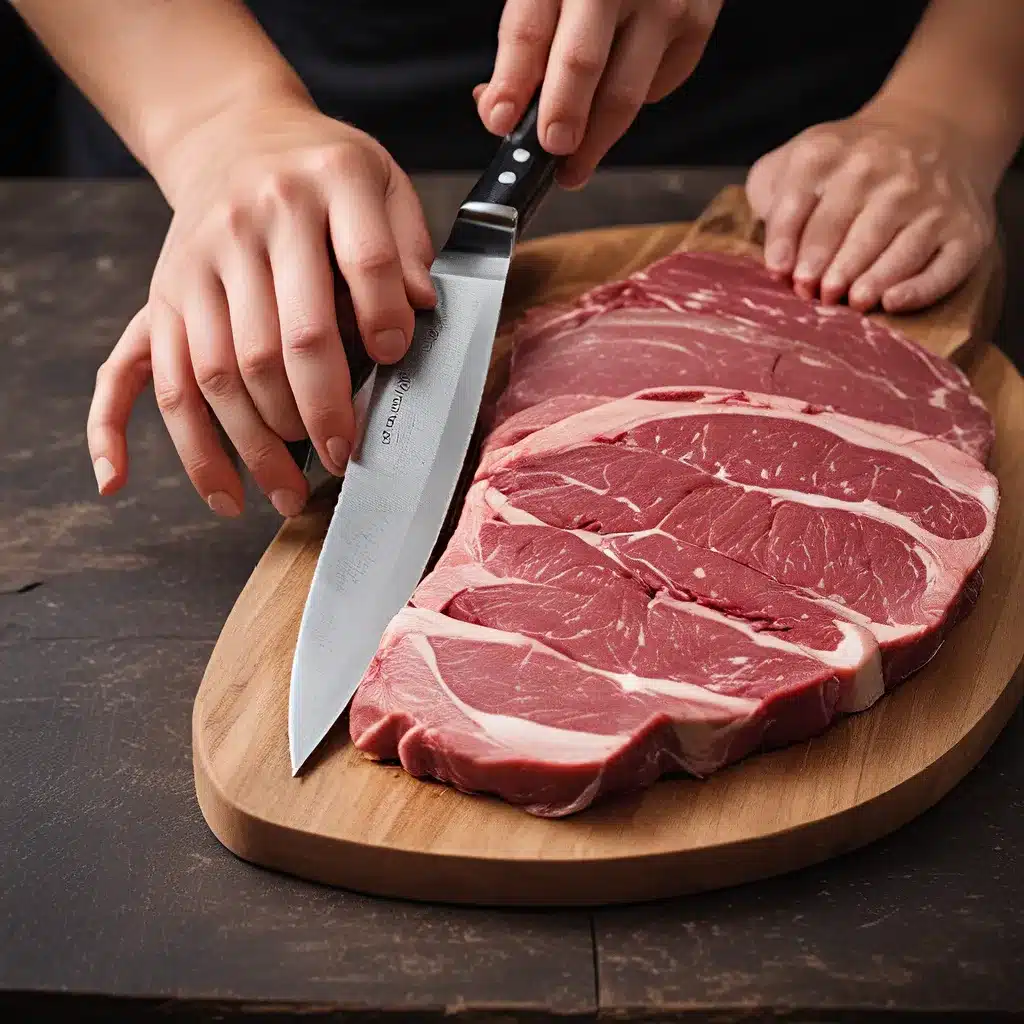
As a self-proclaimed knife enthusiast, I’ve always been fascinated by the art of butchery and the intricate techniques involved in meat cutting. There’s something almost poetic about the way a skilled butcher can transform a slab of meat into a work of culinary art.
The Importance of Proper Knife Technique
When it comes to butchery, the knife is quite literally the most important tool in the trade. A sharp, well-balanced knife in the hands of an experienced butcher can make all the difference in the world. But it’s not just about the knife itself – it’s also about how you use it.
Proper knife technique is essential for both efficiency and safety. Improper knife motions can lead to uneven cuts, ragged edges, and even potential injuries. On the other hand, mastering the right techniques can help you break down a carcass with precision, speed, and minimal waste.
One of the key principles of good knife technique is maintaining a consistent, controlled cutting motion. As the experts over at the eGullet forum explain, “the knife should be held firmly and the cutting motion should be a smooth, continuous stroke.” This allows you to make clean, even cuts without tearing or shredding the meat.
Mastering the Basic Knife Cuts
Of course, knowing how to use a knife is only half the battle. You also need to understand the different cutting techniques and when to apply them. Here are some of the fundamental knife cuts every aspiring butcher should master:
The Slice
The slice is perhaps the most basic and versatile of all the butchery cuts. It involves using the full length of the blade to make smooth, even cuts across the grain of the meat. This is great for slicing thin steaks, chops, or deli-style cuts.
The Chop
The chop is a more forceful, downward cutting motion, often used for tougher cuts of meat. Instead of a long, smooth stroke, you’ll be using quick, vertical chops to break through connective tissue and bone. This is essential for breaking down larger primal cuts.
The Dice
For smaller, more uniform pieces, the dice is the way to go. By using a rocking motion with the knife, you can quickly and precisely cut meat into tiny, evenly-sized cubes. This is great for stew meat, ground meat, or adding texture to dishes.
The Fillet
The fillet is a delicate, precision cut used to remove meat from the bone. With a smooth, controlled slicing motion, you’ll be separating the muscle fibers from the bone, leaving you with a tender, boneless portion of meat.
The Trim
Finally, the trim is all about cleaning up your cuts. Using short, controlled strokes, you’ll be removing any excess fat, silverskin, or imperfections to give your meat a clean, professional-looking finish.
The Importance of Sharpening
Of course, none of these techniques will do you any good if your knife isn’t sharp. A dull blade will tear and shred the meat, rather than making clean, precise cuts. That’s why regular sharpening is absolutely essential for any serious butcher.
Experts recommend sharpening your knives after every use, or at the very least, before each major butchery session. This will ensure your blades stay razor-sharp and ready to tackle even the toughest cuts of meat.
Developing a Butcher’s Instinct
But knife technique is about more than just the mechanics – it’s also about feel and intuition. As you gain more experience, you’ll start to develop a butcher’s instinct that allows you to intuitively assess the meat, choose the right tool for the job, and execute your cuts with confidence and precision.
This kind of intuitive mastery doesn’t happen overnight, of course. It takes years of practice, trial and error, and a deep understanding of the science and art of butchery. But for those who are willing to put in the work, the rewards can be immense.
Exploring the Science of Meat Cutting
And speaking of the science of butchery, there’s a fascinating world of meat science that can help us understand the nuances of this craft. As meat scientist Carly DeFilippo explains, “the way we cut meat can have a big impact on its texture, flavor, and overall quality.”
For example, did you know that the direction of the muscle fibers can affect how tender a cut of meat is? Or that the freshness of the meat can influence how easily it releases from the bone? These are the kinds of insights that can make all the difference when you’re trying to coax the maximum flavor and texture out of your cuts.
Putting It All Together
Ultimately, mastering the art of butchery is about more than just sharpening your knives and practicing your cuts. It’s about developing a deep understanding of the science, honing your intuitive instincts, and continuously refining your technique.
And of course, it’s about passion – the kind of passion that drives you to endlessly experiment, to push the boundaries of what’s possible, and to constantly strive for perfection.
So if you’re looking to take your meat cutting skills to the next level, I highly recommend checking out the resources over at HermanKnives.net. Their top-quality knives and expert tutorials can help you unlock the full potential of your butchery prowess.
Who knows – with the right tools and a little elbow grease, you might just discover the artist within.


